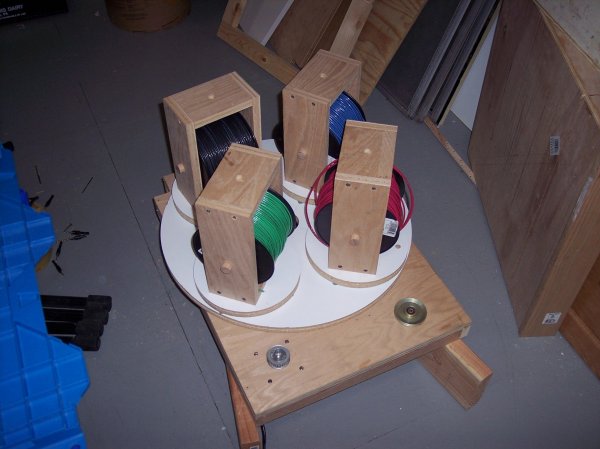Thanks, jn. No, no stranger at all.
I don't understand what you're trying to say in this sentence: "Twisting with a drill will not do that, as the unwrap will open the spacing. Hand twisting, or machine where the spools counter-rotate can do this also."
Sorry, I'm rarely clear...
When we need a specific twisted pair or tri, we normally just unspool the amount needed plus abut 5%, tie one end to a doorknob or some equally technical attach point, and chuck an eyebolt or coathanger into a hand drill. Attach the wires to the drill, then spin it while keeping tension. It is necessary to overtwist the wires, because when you cut the end near the drill, the entire length will untwist to some resting pitch, that needs to be controlled by holding the wire and letting it untwist under tension and in control. When it is over, the wires will no longer be really tightly twisted. Depending on the conductor and the insulation, they could actually not be in good contact anywhere. The untwisting is a consequence of the technique with the drill. For each full 360 degree twist of the bundle, each conductor is also twisted 360 degrees. They fight that, and untwist the bundle as a result.
If you take 10 feet of two or three wires, and twist them while allowing the far ends to be free, you will not introduce twist of the individual conductors. The bundle will remain tighter as a result. If you make a twisting fixture that held the feed spools, and forced the spools to not rotate relative to you, yet revolve around each other, that will work. If you make the spools rotate in the opposite direction of the revolving, you can pre-load the conductors such that they will try to twist the bundle more and remain in good contact. I made one using a 12 inch lazy susan, 4 6 inchers, some plywood, and 4 spools of #12awg from HD. I'll attach a pic when I find it..
Twisting will work to accomplish controlled impedance of all combinations. It is only important that the cross sectional geometry remain the same. As I pointed out, a tri twist does not give common centroids for any combination of two, but only for all three, so will by design, make the cable a tad more susceptible to nearfield time varying flux fields.Also, I believe you would need to be concerned with not only the impedance between + and pin 1, - and pin 1, bit also between + and -. Could a triad even be done that would accomplish that? Maybe an over/under braiding, but I'm not sure that would net out to the same thing.
--Bill
Cheers, jn
ps...apologize for the size of the picture, I'm still learning here...















